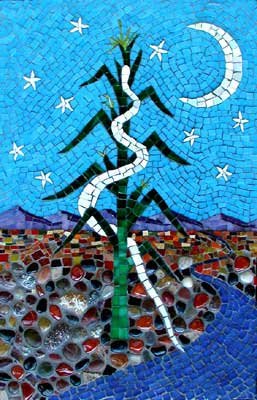
“Corn Snake” mosaic art. carnelian, smalti, stained glass, ceramic,
tumbled glass, beach stones, grout on panel. 14 in x 22 in
“Corn Snake” Contemporary Mosaic Art
The following is an excerpt from my interview with Lisa Graley in The Humanities Education and Research Association’s Interdisciplinary Humanities journal, fall 2003 issue, in which I talk about the Corn Snake mosaic and my career in fine art:
MOORMAN: I was driving across the Southwest, right before I made Cornsnake. I was driving as fast as I could—I don’t mean speeding—but I was moving, and not on vacation. You know, it would take you days and days to drive across a state if you were stopping to explore every little creek bed you came across. So I wasn’t doing any of that, but I had to stop and sleep somewhere. I stopped at the less visited state parks, dirt roads, that sort of thing. And I was sleeping in the desert, on top of the back of the U-Haul, so I could watch the Perseid meteor shower -it was August. One day I stopped at a place in New Mexico that was a national monument or park for the ruins of this Native American village in the middle of nowhere . I could see this dried-up riverbed and the remains of the village, tiny, maybe twelve to twenty structures, just the outlines of the walls, sitting out on this empty desert scrubland. And I was thinking this was everyday life for the inhabitants—it wasn’t a romantic view but really a sad view—maybe like in As I Lay Dying–that here were these twenty or so people stuck with the same twenty people, people they loved, people they wanted to get away from, people they hated, in this tiny settlement, and all around them was this vast emptiness. And probably they didn’t interact with any other people—or maybe just with other people like themselves in some distant villages.
And there was that empty riverbed, with just a trickle of water, maybe what we wouldn’t even call a river in the east, and it was all kind of eerie. I’d been thinking about a snake crawling up a tree already. And then I saw that dirty little creek bed—just rocks, and I was thinking of the beauty of it, that it was intensely beautiful, and that this was the center of the world for them. And like I said, all around was just this vast emptiness.
LISA GRALEY: You’re talking about emptiness—when here you have this mosaic—and it’s not empty at all. It’s vibrant with life.
MOORMAN: Yes, I don’t want to say much about it. But that’s it. The magic moment. At night in the desert is when the animals who’ve been sleeping all day come out. The stars are so bright, they’re nearly singing. The sun has been baking all day and there’s been this oppressive heat, but suddenly, there’s this magic. And I meant for it to be magical and engendering.

